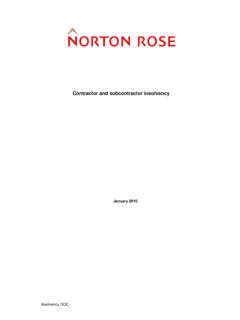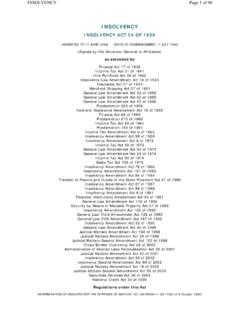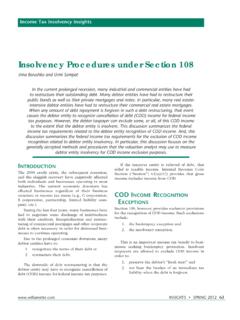Transcription of CHAPTER I: GENERAL FRAMEWORK OF INSOLVENCY LAWS …
1 EMERGING INSOLVENCY IN INDIA: ISSUES & OPTIONS 1 CHAPTER I: GENERAL FRAMEWORK OF INSOLVENCY laws IN INDIA HISTORICAL BACKGROUNDP0F1P The need for an INSOLVENCY law in India was first articulated in the three Presidency-towns of Calcutta, Bombay and Madras. The earliest rudiments of INSOLVENCY legislation can be traced to sections 23 and 24 of the Government of India Act, 1800, which conferred INSOLVENCY jurisdiction on the Supreme Court at Fort William and Madras and the Recorder's Court at Bombay. These Courts were empowered to make rules and order for granting reliefs to insolvent debtors on the lines intended by the Act of the British Parliament called the Lord's Act passed in The passing of Statute 9 in 1828 (Geo. IV. c. 73), can be said to be the beginning of the special INSOLVENCY legislation in India.
2 Under this Act, the first INSOLVENCY courts for relief of insolvent debtors were established in the Presidency-towns. Although the INSOLVENCY Court was presided over by a judge of the Supreme Court, it had a distinct and separate existence. The INSOLVENCY Court was to sit and dispose of INSOLVENCY matters as often as was necessary. But the Court at Calcutta was to sit at least once a month. The Act of 1828 was originally intended to remain in force for a period of four years, but subsequent legislation extended its duration upto 1843 and also made certain amendments 2F3 A further step in the development of INSOLVENCY Law was taken when the law in 1848 (11 & 12 ) was passed. The Act presumed the distinction between traders and non-traders in certain respects on the lines of the corresponding Bankruptcy statutes, then in force in England.
3 It continued the Courts for the relief of insolvent debtors established by the Act of 1828 in the Presidency towns and in their place the present High Courts were set up. The INSOLVENCY jurisdiction in the Presidency towns was thus transferred from the Supreme Court to the High Court. The Provisions of the Indian INSOLVENCY Act, 1848, were, however, found to be inadequate to meet the changing conditions. In the eighteen seventies Sir James Fitzjames Stephen proposed an INSOLVENCY Bill for the whole of India modeled on the Bankruptcy Law then in force in 1 Prepared in the Directorate of Academics and Professional Development, the ICSI 2 J P S Sirohi, Law of INSOLVENCY (1985) 3 See Mulla Law of INSOLVENCY in India(1958), EMERGING INSOLVENCY IN INDIA: ISSUES & OPTIONS 2 England.
4 But this proposal was dropped, as the conditions in India in GENERAL were not favourable for a compulsive legislation on the subject. The Act of 1848 continued in force in the Presidency-towns until the enactment in 1909 of the present Presidency-towns INSOLVENCY Act, 1909. While there was special INSOLVENCY legislation for the Presidency-towns, there was no INSOLVENCY law in the rural areas. The main reason for this difference was the absence of any flourishing trade and commerce therein. In the rural areas for a considerable period the ordinary principle of distributing the sale proceeds pronotes among decree-holders after satisfaction in full of the amount due to the attaching decree holder seems to have prevailed. The first attempt to introduce INSOLVENCY law in the rural areas was made in 1877.
5 Some rules were incorporated in CHAPTER 20 of the Code of Civil Procedure, 1877, which conferred jurisdiction on the district Courts to entertain INSOLVENCY petitions and grant orders of discharge, these rules were re-enacted with certain modifications in CHAPTER 20 of the Code of Civil Procedure, 1882. The Provisions in the Civil Procedure Code of 1859 were describedP3F4P as the "germ and nothing more than a germ of an INSOLVENCY law." The provisions were limited to cases in which legal proceedings were instituted and judgment obtained. Creditors of a debtor were not entitled to file an INSOLVENCY petition. These defects were removed by the provincial INSOLVENCY Act, 1907. This Act created a special INSOLVENCY Jurisdiction laying down the conditions under which a debtor could be adjudicated on his own petition or on a petition by a creditor.
6 The Act of 1907 was repealed by the provincial INSOLVENCY Act, 1920 which is the Act now in force in the areas other than the Presidency towns. CENTRAL AND STATE LEGISLATIONS On January 26, 1950 the Constitution of India came into force. The laws /Acts enacted after its adoption are called the Central laws /Acts. For Example the Companies Act, 1956, Limited Liability Partnership Act, 2008 (LLP) etc, (this contains the detailed process for the winding up of the corporate entities). These are called the Central Acts, wherein the Companies/LLPs are 4 See Mulla Law of INSOLVENCY in India (1958), EMERGING INSOLVENCY IN INDIA: ISSUES & OPTIONS 3 required to get themselves registered with the Central Registry known as the Registrar of Companies /LLP in order to become corporate entities.
7 However, before the adoption of the Constitution of India, many laws /Acts governing the INSOLVENCY procedures were in operation like the Provisional INSOLVENCY Act, 1920, and the Presidency Towns INSOLVENCY Act, 1908. Government of India saved these Acts so that they do not get repealed and allowed for State Amendments wherein the entities provided for under those Acts are regulated by different States and the States were given the authority to modify or make provisions in these Acts. Since, the personal INSOLVENCY is a subject matter of State List over which laws can be made by the State Legislation. Hence any amendment in these Acts will require acceptance or assent, from all the States or the States can individually amend these laws /Acts. CURRENT SCHEME OF INSOLVENCY laws IN INDIA The stream of INSOLVENCY laws can be segregated chiefly under two heads: Personal INSOLVENCY , which deals with individuals and partnership firms governed by Provisional INSOLVENCY Act, 1920 and Presidency Towns INSOLVENCY Act, 1908 and Corporate INSOLVENCY , whose consequence is winding up of the company under the Companies Act, 1956.
8 In context of corporate laws , the word " INSOLVENCY " has neither been used nor defined in India. However, Section 433 (e) of the Companies Act, 1956 covers a company, which is "unable to pay its debts", and thus constitutes a ground for winding up of the company. Inability to pay its debts would be a case where, a company's entire capital is lost in heavy losses and no accounts are prepared and filed and no business is done for one year. In such circumstances, the Registrar of Companies makes out a case of inability to pay debts. These debts however, would only include debts, incurred after the legal incorporation of the Company. Inability to pay debts has even been amplified in Section 434 of the Companies Act, 1956 wherein, a creditor with a due of Rs. 500 or more serves a demand by registered post and the company neglects to pay, secure or compound the same in three weeks, in cases where the execution of a decree returned unsatisfied and also where the Court is otherwise satisfied that the company is unable to pay its ** 5 Sourced from: EMERGING INSOLVENCY IN INDIA: ISSUES & OPTIONS 4 CHAPTER II: A FRAMEWORK FOR REHABILITATION OF COMPANIES INTRODUCTION India started her quest for industrial development after independence in 1947.
9 The industrial policy resolution of 1948 marked the beginning of the evolution of the Indian Industrial Policy; and thereafter with the economic and social development there has been shift in the industrial policy from the directed and regulated economy in the 1948 and 1956 Policy Resolution, to the free market economy in 1991. During the initial years, there was also the problem of industrial sickness entailing social costs in terms of loss of production and un-employment and waste of capital assets. The problem of industrial sickness and its consequential fall out on the nation s economy and also the problem faced by financial institutions (which have invested much of the public funds in such industries) in the matter of recovery of their dues and the rehabilitation of the sick industrial company led to enactment of the Sick Industrial Companies (Special Provisions) Act, 1985.
10 P5F6 INDUSTRIES DEVELOPMENT AND REGULATION ACT [I (D & R) A], 1951 The [I (D & R) A] is an important piece of legislation for the development and regulation of certain industries. It contains provisions for the regulation of industries to prevent industrial undertakings from falling sick and consequently hampering the production of materials necessary for the economic development of the country. P6F7 SICK INDUSTRIAL COMPANIES (SPECIAL PROVISIONS) ACT, 1985 (SICA) AND [I (D & R) A] The two Acts ; the [I (D & R) A] and SICA operate in different fields though they would appear to be overlapping. The [I (D & R) A] was enacted for the development and the regulation of certain industries. The [I (D & R) A] applies to industries mentioned in the schedule to the Act and the SICA is applicable to those very companies having industries as mentioned in the schedule to the [I (D & R) A].






